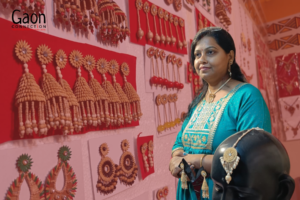Varanasi, Uttar Pradesh
Bijli wali chaak, or electric pottery wheel, is transforming the lives of the Prajapati community in Varanasi. Using these wheels, which run on electricity and do not require manual labour, the kumhaar (potter) are shaping earthen lamps and other clay-based items at a much faster pace, thereby increasing their earnings in the festival season of Diwali.
Ramraj Prajapati, a 40-year-old resident of Bhatti village in Uttar Pradesh’s Varanasi district has been working as a potter for the last 10 years but the demand for his diyas (earthen lamps) is unprecedented in this Diwali season.
“Last year, I sold around dedh lakh diya [150,000] but this year, the demand has hit the roof. I have made almost 300,000 diyas this Diwali and the orders are still coming. I am expecting a good earning this season but I wouldn’t have been able to make this many diya had I not been provided with bijli wali chaak,” Prajapati told Gaon Connection.
“Without the bijli wali chaak, earlier I used to earn Rs 500 a day in the Diwali season, but now I am earning Rs 1,000 to Rs 1,200 as my production has doubled,” the potter added.
Also Read: The flower growers of Varanasi hope to see sales bloom during Diwali
The 40-year-old is amongst 147 potters in the Varanasi district who have been provided with the electricity-operated pottery wheels free of cost by the Khadi and Village Industries Commission. The distribution of these wheels has helped scale up the production of earthen lamps and other decorative items that are in huge demand in the Diwali festival.
When Gaon Connection contacted UP Singh, the Khadi and Village Industries Board Officer in Varanasi, he stated that more electric-wheels are about to arrive in the district and they will be distributed to the potters in December.

“So far, 147 such wheels have been distributed to the people of the Prajapati community. Forty more electric wheels will be distributed in December and we are working to improvise the livelihoods of the potters in the district,” Singh said.
“Also, apart from these 147 potters, a total of 1,742 mechanised tools have been distributed amongst the rural residents in the district. The target for providing employment to these residents was 544 this year but we have provided livelihoods to 1,198 people,” he added.
Also Read: Uttar Pradesh’s Unnao has a unique tradition of celebrating Dussehra 6 days late. Here’s why
Ramashray Prajapati, a potter working with the government’s Small Enterprises Cell told Gaon Connection that there are almost 50,000 potters in Varanasi and the introduction of electric wheels will boost the productivity of these potters.
According to Prajapati, “The electric chaak has helped bring prosperity in the potters’ households. We are able to afford better education for our children now.”

In some households, diya-making is something that only the women-folk are engaged with.
However, Shivshankar Prajapati, another potter who received the electric chaak told Gaon Connection that the expenses on electricity bill have increased due to the electric wheel.
“The electricity bill has increased ever since we began using the electric wheel. Earlier, the electricity bill was Rs 500 per month but now it’s easily Rs 800,” he said.
‘Unsold idols from Corona expected to sell now’
Also, some potters told Gaon Connection that two years of low sales during the COVID-19 pandemic is now expected to compensate for their previous losses as the unsold idols of Ganesh and Lakshmi are being marketed now.
“There were lots of idols lying with us from the two previous Diwalis but I am hoping that that stock will be cleared now. Almost 3,000 idols from previous years and another 4,000 that we have made this year are being sold and I wish the profits are far better this year,” Ganga Prajapati told Gaon Connection.
Also, Ganga Prajapati shared that diya-making is something that the women-folk in her family are engaged with.
“It is the women who make diyas in my household. It also helps us in making ourselves self-reliant as we have the earnings of our own and do not depend on the men financially,” she said.

















